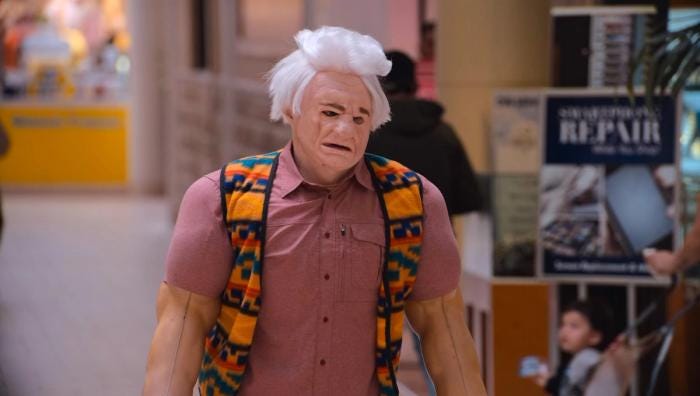“I’m Really Crossed Up”: Tim Robinson’s I Think You Should Leave and VR-Induced Dissociation
A surreal sketch comedy show's insights on VR and embodiment
Tim Robinson’s popular Netflix sketch comedy series I Think You Should Leave (ITYSL) explores how characters react when faced with awkward situations taken to their extreme. Some bits show a character taking things way too far and refusing to back down, while others add a dollop of surrealism by turning an everyday situation on its head and surprising the audience with the unexpected. Sketches in the show are often crass, uncomfortable, and cringe-inducing—but they are also hilarious.

The show also, at times, plays with horror themes and elements of the uncanny. Through this dichotomy of the painfully awkward and the funny, the show at times acts as a lens through which we can examine serious topics like technology and embodiment. This essay will explore the ways in which one sketch in I Think You Should Leave uses the joint forces of horror and comedy to reveal societal anxieties about technology—more specifically, virtual reality and the potential for virtual reality (VR)-induced dissociation.
The sketch in question occurs at the very beginning of season 3, episode 2. The episode is titled “I CAN DO WHATEVER I WANT.” The premise of the sketch is a father-son pair competing on Supermarket Swap: VR Edition, a modernized version of a gameshow akin to the classic Supermarket Sweep. Instead of racing around a real, physical set of a grocery store, though, contestants must put on a VR headset and navigate a virtual shopping market. Contestants control an avatar in the gamified VR world and must grab digital goods.
However, the sketch soon takes a turn towards the ridiculous when the father character, played by Tim Robinson and named Mr. Mitchell, or Mike, discovers that he is unable to breathe while wearing the VR headset. From the moment Mike puts the headset on for a 30 second shopping spree, his mouth is clamped tightly shut and he begins making odd facial expressions while his avatar in the simulated supermarket stands motionless.
“I don’t think he’s breathing,” the host worries after a few moments.

Mike begins struggling visibly, gripping the arms of his chair tightly and writhing around in a panic. The other characters, including Mike’s son and the host, continuously tell him to breathe and to simply open his mouth. However, Mike seems unable to obey their instructions. Eventually, an assistant or producer on the show runs over and removes the headset from Mike’s head, prompting him to scream hysterically. Mike begins to take a few deep breaths, and a moment later notices he still has the VR gloves/sensory equipment attached to his hands and begins screaming anew. Oddly, it’s almost as though the mere knowledge that the technology was still on his hands was what affected him, rather than any actual physiological impact the technology was having, because a mere moment before he was seemingly beginning to calm down and catch his breath—until he noticed the still-attached equipment.
Once Mike is helped out of the VR headset and gloves, the gameshow host has a chance to ask just what the heck happened when Mike entered the simulation.
“I don’t know how to work the body.”
The host appears exasperated at this response, as she tries to explain “It’s you. It’s you in there. You just need to breathe.” As she says this, however, Mike’s face is contorted in apparent confusion as he struggles to follow what she is saying.
Mike then begins to question how we control our bodies in the real world. “How do we move our bodies ever? I don’t think I can walk. I’m thinking about it too much. I’m really crossed up.” He again shuts his mouth and becomes unable to breathe.
The sketch ends a moment later. The final shot of the scene as the show’s theme music begins to play is Tim Robinson’s character instantaneously morphing into a mannequin-like figure akin to a computer-generated avatar.

So, what exactly happened to Mike in ITYSL’s VR sketch? He seemingly encountered a disconnect between his body in the virtual world and his body in the corporeal world. The brief few seconds he spent in VR appeared to have affected him so profoundly that his entire sense of corporeal embodiment has been rewired.
This sketch is funny for a number of reasons, but the principal joke is absurdist in nature: the idea that an average, normal guy would so suddenly lose his ability to walk and even breathe due to an extremely brief foray into VR simply because it has caused him to start “thinking about it too much.” In an almost Black Mirror-esque fashion, though, this sketch isn’t just silly. It has real things to say about embodiment and just how much we take our bodies and our bodily control for granted. Typically, we don’t think about how to move our legs to cause our bodies to walk, or how to breathe. Our day-in day-out existence sees us giving very little thought to these automatic or nearly automatic, subconscious processes—really, most of us are quite content to leave these things to the realm of the subconscious and the automatic.
In reality, there is some research which demonstrates the capacity for VR to result in dissociative symptoms; these can even be common, though they are short-term and certainly not to the degree that one would forget “how to work” their body à la Tim Robinson’s character (van Heugten-van der Kloet et al., 2018; Taveira et al., 2022).
More interesting than (relatively minor) real-world impacts of VR on embodiment, however, are the cultural anxieties this sketch reveals. Loss of bodily autonomy is, of course, a medical reality for many, and a source of apprehension for others. Mike’s loss of control suggests a fragmentation of his embodied identity; that is, he is split—or as Mike himself remarks, “crossed up”—between his corporeal body and his virtual body. Mike experiences a dichotomy, a contradiction, between his physical self and his technological avatar. For Mike, his consciousness seems to experience embodiment in two separate selves at once, causing him to question the most basic and fundamental aspects of how we operate our fleshy bodies.
This splitting of the self into multiple realms—the domain of the material and the domain of the virtual—certainly cuts to the heart of cultural worries over the impact of technology on identity and control. Further, there truly is a phenomenon most of us have experienced in which awareness of our own bodies becomes uncanny and straight up weird when examined too closely—or, as in Mike’s case, when we are forced to confront the surrealness of of our own embodied consciousness.
However, unlike Black Mirror, I Think You Should Leave takes the approach of parody rather than taking these concerns all that seriously. After all, it can’t be ignored that ITYSL is an irreverent comedy show. As we’ve already discussed, while research shows that VR can induce dissociative effects, these are generally minor and resolve extremely quickly. Too often, we as a society are technophobic to an irrational degree—it seems that just about every technological advancement incites a reflexive response of fear. The printing press, for example, raised concerns within the Church for its potential to facilitate the spread of heretical ideas (Johnson, 2023). Some feared the telephone had the ability to “attract evil spirits” (Ehrenkrona). And we’ve all heard the concerns that video games may be responsible for violence and a general moral decay.
We have a tendency to fear that which is new. And yes, some technologies come with good reason to be apprehensive. There are plenty of legitimate concerns about technology and privacy, video games and the addictiveness of lootbox-style gambling, and the effects of smart phones, screen time and enduring, perpetual connectedness—not to mention AI and the pandora’s box of issues that accompany it. But the point is that there is some cause to be skeptical of technophobia for technophobia’s sake.
ITYSL perfectly parodies Black Mirror-style technohorror by demonstrating just how silly some kinds of technological anxieties can be. After all, the very premise of this sketch is ludicrous—of course we don’t really think that VR headsets can cause you to forget how to breathe or become so puzzled over the disconnect between your physical body and your virtual one. That’s why this sketch is perfect for pointing out that, yes, there are real concerns associated with various technologies, but the correct response is not to jump to extremes of luddite paranoia over every new thing that comes out. The correct response is caution—to appreciate the countless benefits of technology while being prepared to address the downsides. And while we’re at it, we can appreciate a good comedy sketch while simultaneously delight in taking it way too seriously.
Further Reading
“‘The telephone is the instrument of the devil’” by Marika Ehrenkrona
“Out-of-Body Experience in Virtual Reality Induces Acute Dissociation” (2018) by Dalena van Heugten-van der Kloet, Jan Cosgrave, Joram van Rheede, and Stephen Hicks
“Printing and Censorship” (2023) by Harlan Johnson
“Virtual Reality-Induced Dissociative Symptoms: A Retrospective Study” (2022) by Mariana C. Taveira, João de Sá, and Michele Gomes da Rosa


